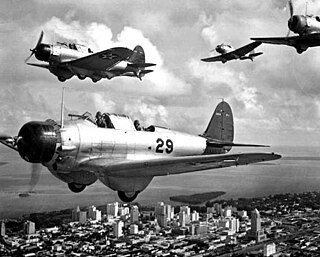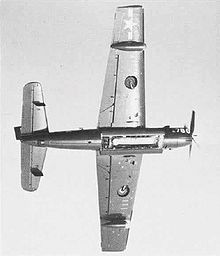
The Douglas A-1 Skyraider is an American single-seat attack aircraft in service from 1946 to the early 1980s, which served during the Korean War and Vietnam War. The Skyraider had an unusually long career, remaining in front-line service well into the Jet Age ; thus becoming known by some as an "anachronism". The aircraft was nicknamed "Spad", after the French World War I fighter.

The Grumman S-2 Tracker was the first purpose-built, single airframe anti-submarine warfare (ASW) aircraft to enter service with the United States Navy. Designed and initially built by Grumman, the Tracker was of conventional design — propeller-driven with twin radial engines, a high wing that could be folded for storage on aircraft carriers, and tricycle undercarriage. The type was exported to a number of navies around the world. Introduced in 1952, the Tracker and its E-1 Tracer derivative saw service in the U.S. Navy until the mid-1970s, and its C-1 Trader derivative until the mid-1980s, with a few aircraft remaining in service with other air arms into the 21st century. Argentina and Brazil are the last countries to still use the Tracker.

The North American AJ Savage is an American carrier-based medium bomber built for the United States Navy by North American Aviation. The aircraft was designed shortly after World War II to carry atomic bombs and this meant that the bomber was the heaviest aircraft thus far designed to operate from an aircraft carrier. It was powered by two piston engines and a turbojet buried in the rear fuselage. The AJ-1 first became operational in 1950 and several were based in South Korea during 1953 as a deterrent against North Korea. Of the 140 built, plus three prototypes, 30 were reconnaissance aircraft. Inflight-refueling equipment was deployed on the Savage in the mid-1950s. The bomber was replaced by the Douglas A3D Skywarrior beginning in 1957. The type was used after its military service for some additional experiments including microgravity test flights and to test a new jet engine in the 1960s and 70s.

The Martin P5M Marlin, built by the Glenn L. Martin Company of Middle River, Maryland, was a twin piston-engined flying boat that entered service in 1951, and served into the late 1960s with the United States Navy performing naval patrols. It also served with the United States Coast Guard and the French Navy. 285 were produced.

The Grumman TBF Avenger is an American World War II-era torpedo bomber developed initially for the United States Navy and Marine Corps, and eventually used by several air and naval aviation services around the world.

The Consolidated TBY Sea Wolf was a United States Navy torpedo bomber of World War II. It was designed by Vought but entered service and was manufactured by Consolidated Aircraft due to high demand for production lines. A competitor and contemporary to the Grumman TBF Avenger, both were designed to replace the older TBD Devastator but the Sea Wolf was subject to substantial delays and never saw combat in WW2. The design was developed a bit further, with a large Navy order for 1100, but only 180 of the TBY-2 type were built before cancellation after VJ Day. An order of 600 for the TBY-3 was also stopped.

The Martin AM Mauler was a single-seat carrier-based attack aircraft built for the United States Navy. Designed during World War II, the Mauler encountered development delays and did not enter service until 1948 in small numbers. The aircraft proved troublesome and remained in frontline service only until 1950, when the Navy switched to the smaller and simpler Douglas AD Skyraider. Maulers remained in reserve squadrons until 1953. A few were built as AM-1Q electronic-warfare aircraft with an additional crewman in the fuselage.

The Grumman F8F Bearcat is an American single-engined, carrier-based, fighter aircraft introduced in late World War II. It served during the mid-20th century in the United States Navy, the United States Marine Corps, and the air forces of other nations. It was Grumman Aircraft's last piston-engined fighter aircraft.

The Ryan FR Fireball was an American mixed-power fighter aircraft designed by Ryan Aeronautical for the United States Navy during World War II. It was the Navy's first aircraft with a jet engine. Only 66 aircraft were built before Japan surrendered in August 1945. The FR-1 Fireball equipped a single squadron before the war's end, but did not see combat. The aircraft ultimately proved to lack the structural strength required for operations aboard aircraft carriers and was withdrawn in mid-1947.

The Grumman F2F was a single-engine, biplane fighter aircraft with retractable undercarriage, serving as the standard fighter for the United States Navy between 1936 and 1940. It was designed for both carrier- and land-based operations.

The Grumman FF "Fifi" was an American biplane fighter aircraft operated by the United States Navy during the 1930s. It was the first carrier aircraft with retractable landing gear. It was produced under licence in Canada and known as the Goblin in Canadian service and Delfín in Spanish service.

The Consolidated PB4Y-2 Privateer is an American World War II and Korean War era patrol bomber of the United States Navy derived from the Consolidated B-24 Liberator. The Navy had been using B-24s with only minor modifications as the PB4Y-1 Liberator, and along with maritime patrol Liberators used by RAF Coastal Command this type of patrol plane was proven successful. A fully navalised design was desired, and Consolidated developed a dedicated long-range patrol bomber in 1943, designated PB4Y-2 Privateer. In 1951, the type was redesignated P4Y-2 Privateer. A further designation change occurred in September 1962, when the remaining Navy Privateers were redesignated QP-4B.

The Northrop BT was an American two-seat, single-engine monoplane dive bomber built by the Northrop Corporation for the United States Navy. At the time, Northrop was a subsidiary of the Douglas Aircraft Company. While unsuccessful in its own right, the BT was subsequently redesigned into the Douglas SBD Dauntless, which would form the backbone of the Navy's dive bomber force.

The Grumman XTSF was a proposed twin-engine torpedo scout aircraft, designed by Grumman for the United States Navy towards the end of World War II. Based on the design of the Grumman F7F Tigercat fighter, but enlarged and with the addition of a bomb bay, the XTSF was deemed too large for carrier operations, and the project was cancelled before any aircraft were built. Instead, the Navy chose to order the single-engine XTB3F, which became the successful AF Guardian.

The Boeing Model 15 was a United States single-seat open-cockpit biplane fighter aircraft of the 1920s, manufactured by the Boeing company. The Model 15 saw service with the United States Army Air Service and with the United States Navy as a carrier-based fighter.

The Vought FU was a biplane fighter aircraft of the United States Navy in service during the late 1920s.

The Consolidated P2Y was an American flying boat maritime patrol aircraft. The plane was a parasol monoplane with a fabric-covered wing and aluminum hull. The aircraft was also made by Martin as the P3M, due to an open production contract.

The Curtiss CS was a reconnaissance and torpedo bomber aircraft used by the United States Navy during the 1920s. It was a large single-engine biplane with single-bay unstaggered wings, the design conventional in all respects other than that the lower wing was of greater span than the upper. The CS was built to allow its undercarriage to be quickly and easily interchangeable between wheeled, tailskid undercarriage, and twin pontoons for operation from water. Provision for the carriage of a torpedo was semi-recessed into the underside of the fuselage, blended in behind an aerodynamic fairing. The pilot and gunner sat in tandem open cockpits, while accommodation inside the fuselage was provided for a third crewmember who served as bombardier and radio operator. This station was also provided with a dorsal hatch aft of the gunner's position, and a ventral blister aft of the torpedo recess, which was used for aiming bombs or torpedoes.

The Martin T3M was an American torpedo bomber of the 1920s. A single-engined three-seat biplane, it became a standard torpedo bomber of the U.S. Navy, operating from both land bases and from aircraft carriers from 1926 to 1932.

The Martin T4M was an American torpedo bomber of the 1920s. A development by the Glenn L. Martin Company of their earlier Martin T3M, and, like it a single-engined biplane, the T4M served as the standard torpedo bomber aboard the aircraft carriers of the United States Navy through much of the 1930s.


























